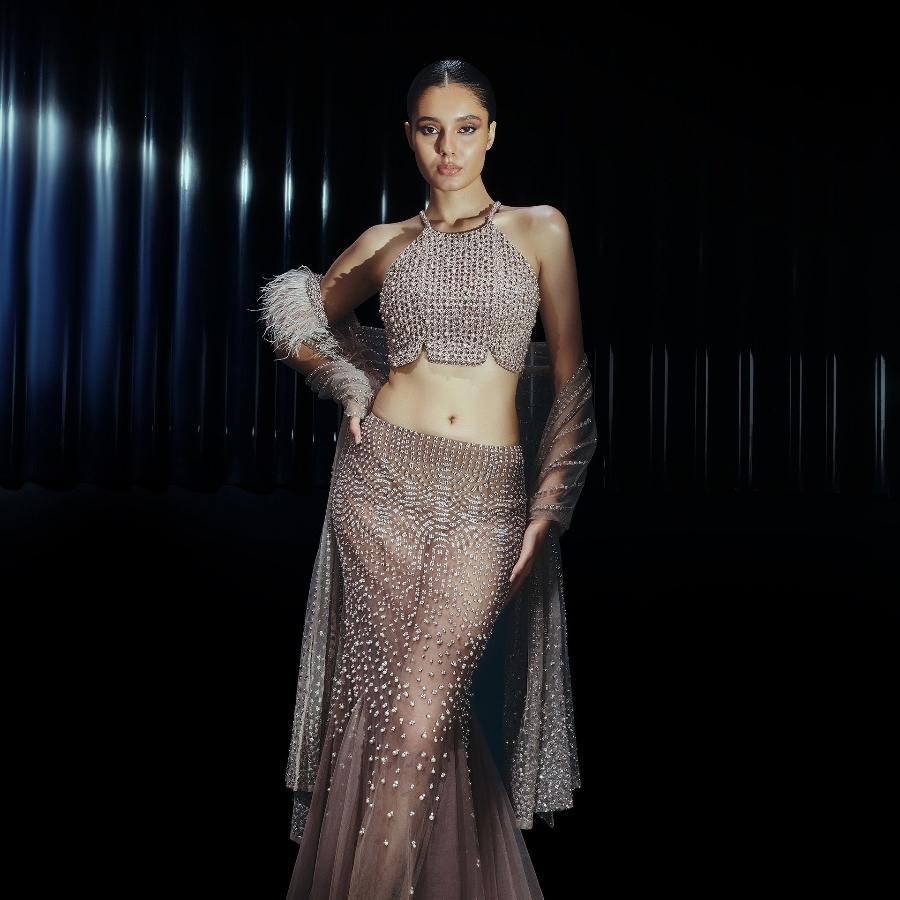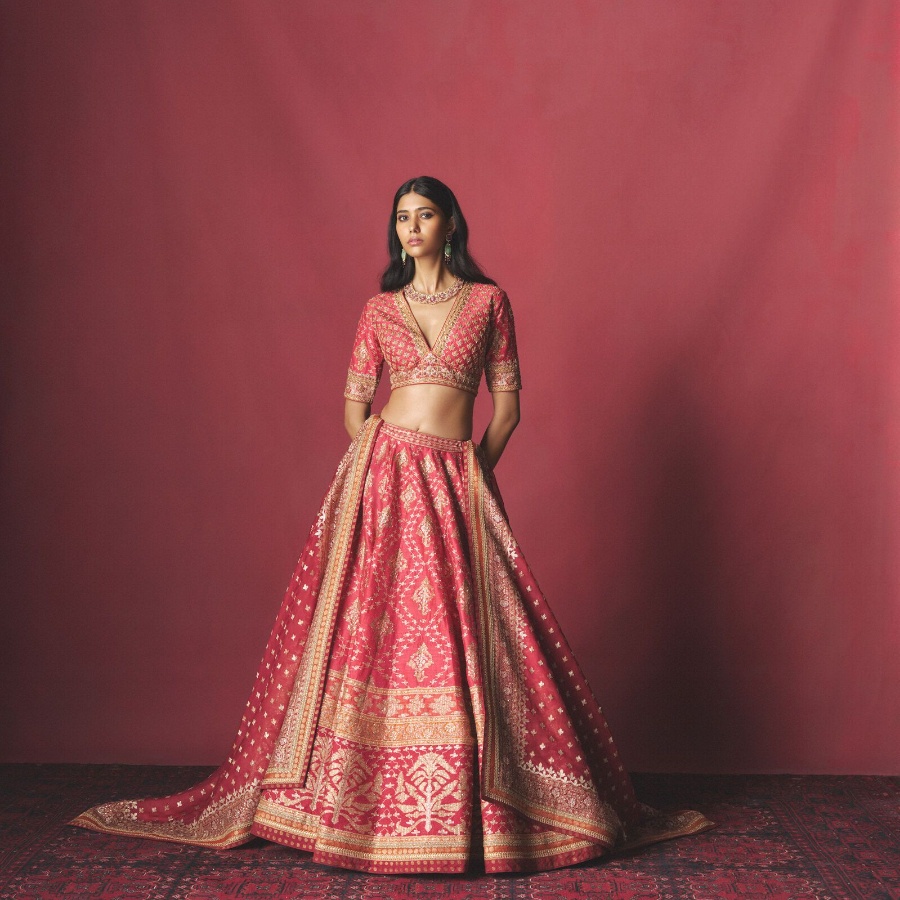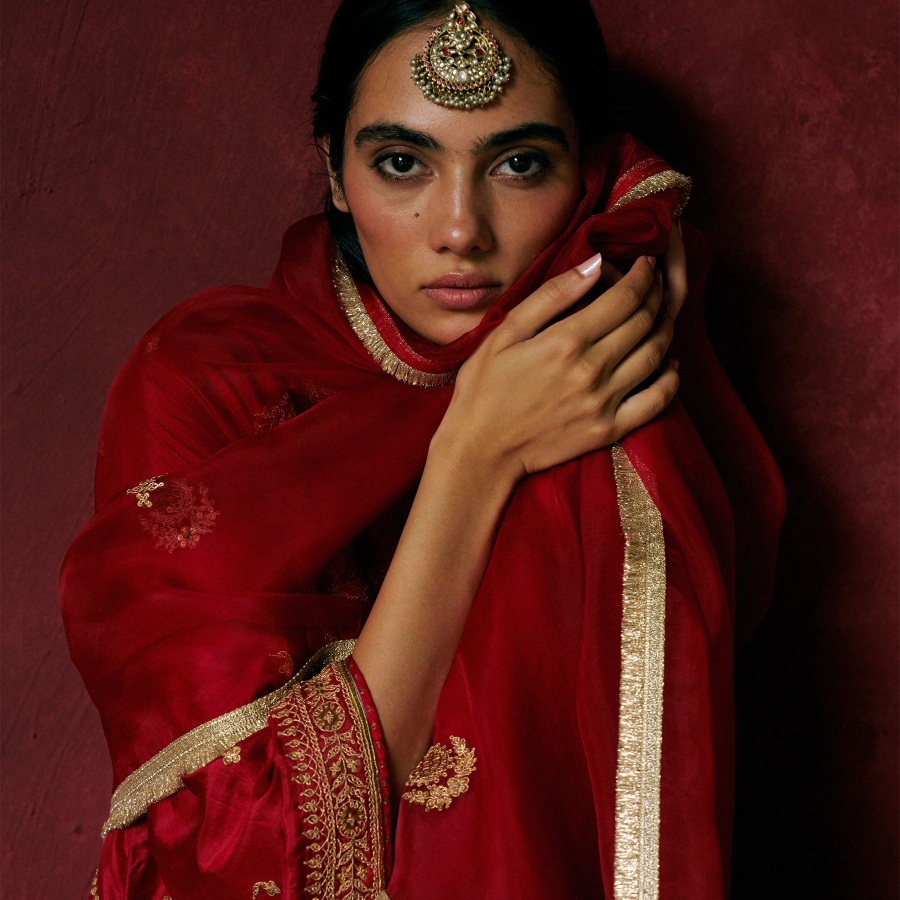This year’s bridalwear trends are marked by a blend of time-honoured traditions and avant-garde innovation to cater to the evolving tastes of modern brides. Whether it’s colour or something as foundational as the fabric, brides-to-be have never been more self-assured in their desire for their wedding wardrobes to reflect their personal style and values. If you are tying the knot this year, here are the biggest 2024 wedding trends to consider.
The pastel palette revolution
It’s hardly unusual to find a bride who chooses red for the main ceremony these days. If famous weddings are anything to go by, pastels and shades of white are in. Kiara Advani chose rose pink, while Athiya Shetty opted for an old rose-hued lehenga by Anamika Khanna for their respective weddings last year. Influencers like Sakshi Sindwani, who tied the knot this January, opted for a coral Manish Malhotra number while Alanna Panday and Julia Haydon wore white for their pheras, defying traditional colour choices.
Pastel shades like blush pink, powder blue and lilac are preferred for their soft, romantic appeal and have become a favourite among brides who seek a subtle yet sophisticated look. Brands like Roseroom Couture and Payal Singhal have breathtaking pastels in their latest collections.
However, they do find themselves in competition with the timeless classics of reds, pinks and maroons, which continue to reign as favourites among brides, according to designers Abu Jani- Sandeep Khosla. “These hues evoke a sense of tradition and cultural resonance that many brides still seek on their special day,” they add.
In response to this, Manish Malhotra is mixing light pastels and rich, deep hues such as bordeaux, royal blue and gold, reminiscent of traditional Indian weddings. “This blend of contemporary pastels and vintage-inspired colours allows brides to find the perfect balance between modernity and tradition, creating a truly unique and captivating bridal look,” says Malhotra.
Designers are aware that trends have a saturation point. “I see colours making a comeback and brides choosing deep Indian colours like emerald green and ink blues,” says Anita Dongre.
In the same camp, Gaurav Gupta’s clients are going in for his signature hues of comet and electric blue this season. “Our other signature colour, lava red, remains a timeless favourite among GG brides,” the designer tells TWC. Shantnu and Nikhil have seen deeper tones and hues, particularly navy blue, emerald, and shades of ruby gaining favour as well.

Heritage crafts as a focus
For brides looking to wear something that will stand the test of time, it might be worth leaning into crafts that are part of India’s rich textile heritage. Malhotra, who is best known for his signature sequins, has been busy reviving age-old artisanal crafts such as Mijwan’s intricate chikankari, Punjab’s vibrant phulkari, textiles with rich Kashmiri craftsmanship and timeless Banarasi weaves.
Abu Jani Sandeep Khosla have also noticed a significant surge in demand for pure fabrics such as khadi, patola and bandhani. Their signature crafts, including chikankari, resham and zardozi, remain perennial favourites among brides and their families, adding heritage style to their celebrations. Younger brands such as Delhi Vintage Co. are taking note. Their latest collection titled ‘Anonymous’ explores vintage aesthetics and labour-intensive traditional techniques on contemporary silhouettes such as jackets, blazers, dresses, embellished pants, shirts and skirts.
“It’s great to see that brides are more and more investing in pieces that have craft attached to them. Be it the timeless heritage of hand-embroidery, the laborious craft of hand-block Ajrakh printing or the precision art of bandhani,” says Dongre.

Sustainability goes beyond a buzzword
Apart from the increased focus on craft, brides are opting for ensembles that can be mixed, matched, re-styled and re-worn on occasions beyond the big day, increasingly taking a more circular approach to fashion. According to Dongre, her brides are big on sustainability, buying outfits that not only make them feel great but can be reimagined for scenarios beyond the wedding festivities.
“It’s refreshing to see that bridalwear now goes beyond just one occasion to multiple moments of a bride’s life,” says Gupta.
“Another interesting movement is the surge of ‘convertible’ dresses during festivities, as people are becoming more experimental with their garments and want to have two bridal looks in one,” couturier Rahul Mishra points out. Think detachable sleeves or an overskirt that can easily switch up the look from one ceremony to the next and can also be styled according to the dressiness of an event later. “Many are becoming more mindful of their surroundings and the larger impact of their celebrations, choosing thoughtful approaches towards sustainability, from decor choices to the very simple process of meal preparation and how it is being served. There’s a lot that one can do for one’s surroundings while celebrating a special occasion like a wedding, and I think that’s very much in trend,” he adds.

Fusion wear 2.0
Fusion wear, which combines traditional Indian elements with contemporary Western silhouettes, has been around for a while but is having a major moment with far-flung destination weddings and cross-cultural unions becoming more common. Think Gaurav Gupta’s lehenga-capes and sculpted gowns, Arpita Mehta’s sequin and mirror hand-embroidered pantsuits, and even embroidered silk minidresses or hand-painted Pichhwai silk skirt sets from Anita Dongre that offer brides the best of both worlds. “Embellished crop tops, ankle-length skirts and mini dresses are fun silhouettes that modern brides are gravitating towards as they are lightweight and effortless,” says Dongre.
In Shantnu and Nikhil’s latest collection, inspired by the architectural marvels of Europe, drapes are paired with fitted corsets in place of traditional blouses. Shweta Kapur at 431-88 has popularised pre-draped saris, often styled with embellished crop tops or jackets.
Gaurav Gupta, who showcased a metal breastplate in his last Paris Haute Couture outing, is reimagining metal as an element in his upcoming collections and looking at using new techniques of metallic zardozi embroidery for bridalwear in a more surreal mythological dimension for his fan-favourite gowns.


Personalised embroidery
Personalisation is key to bridal fashion in 2024. Brides looking to tell their unique stories are requesting bespoke touches to make their wedding garments feel extra special. Embroidery featuring names or initials of the couple, and their vows are becoming common requests. Through intricately detailed embroideries, they are even depicting love stories, baraats, or beloved pets on the fabric.
“A recent example is the ensemble we created for Siddharth Malhotra and Kiara Advani’s wedding. We added personalised messages they wrote for each other, making their wedding attire not just visually stunning but also deeply meaningful,” reveals Malhotra. Mishra recently dressed a bride who wanted her family dog’s caricature embroidered onto her lehenga because the pet couldn’t be flown into the country for the ceremony due to restrictions.
New minimalism
Minimalism continues to be a significant trend, with brides opting for clean lines and understated elegance. However, this minimalism is often accented with a touch of glamour—think subtle shimmer, delicate beadwork, or statement jewellery that complements the overall ensemble without overpowering it. Ritu Kumar’s spring-summer 2024 lehengas and suit sets, with their precise tailoring and restrained embellishments, exemplify this trend.
Kshitij Jalori’s bridal lehengas in silk brocade and silk satin crepe are minimalist favourites as well.

Tasteful maximalism
According to Mishra, modern bridalwear is becoming more versatile with international exposure and the surrounding strong cultural influences. “I’ve been observing a demand for more avant-garde pieces. In my view, maximalism is on the rise because brides are expressing themselves more uniquely with their own selections of fabric and silhouette.” Recently, Mark Zuckerberg wore a fully hand-embroidered couture T-shirt, which garnered significant attention at the pre-wedding celebrations of Radhika Merchant and Anant Ambani in Jamnagar, Gujarat. “The familiarity of the silhouette, combined with heavy embellishments and unique surface applications, creates a formula that works in any new market,” he adds.
Shantnu and Nikhil have seen voluminous taffeta gain favour, while Kresha Bajaj’s signature blingy capes double up as jewels for the body.
“Customised Jadau jewellery and Swarovski-studded blouses have garnered significant momentum as signature Abu Jani-Sandeep Khosla classic creations. The recent iconic blouse worn by Isha Ambani for Anant and Radhika’s pre-wedding festivities, has become an absolute rage for concept and jewel-studded blouses,” say Abu Jani-Sandeep Khosla.


Make way for jewels
Bridal jewellery trends are evolving too, with brides choosing chokers, layered necklaces, and oversized earrings to make a statement. As a result, the silhouettes they opt for when it comes to their garments are also undergoing a shift. “Many brides have been experimental with their garments and silhouettes for their special day, but now I see a big shift towards maximalist jewellery to style their looks,” says Mishra.
“Brides now prefer slightly wider and more open necklines, providing the perfect canvas for highlighting their exquisite jewellery. This shift reflects a growing emphasis on the synergy between attire and accessories in bridal fashion,” add Abu Jani Sandeep Khosla.
Shantnu and Nikhil too are prioritising strapless necklines and corsets which leave plenty of room for experimental jewellery to shine through.

The contemporary veil
While the dupatta remains a staple in Indian bridal wear, the veil has undergone a contemporary transformation. Sheer, lightweight, and often adorned with intricate lace or embroidery, the modern bridal veil adds a touch of ethereal beauty. “Surprisingly, head veils have emerged as a notable trend in 2024, with brides opting for long versions to go with their wedding ensembles,” say Abu Jani Sandeep Khosla.
Malhotra’s long veils, often paired with his cut-open back or infinity blouses, have become an increasingly popular and elegant choice.

Trousseau-worthy picks
The bridal trousseau is a curated collection that is reflective of the bride’s personality and style. Beyond the wedding day attire, it includes pre-wedding outfits and post-wedding ensembles. Ashdeen’s Parsi Gara embroidery sarees that incorporate Chinese, Persian, European, and Indian styles are exquisite and would make for the perfect addition to any fashion-forward bride’s wardrobe. For brides looking to add Benarasi weaves to their collection, take a look at Tantuvi by Smirti Morarka. Ekaya has monochromatic silk, organza, and tissue sarees with delicate hand-embroidered details like scallop borders in every colour. Kanakavalli’s collection of kanjivaram silk sarees is unrivalled, while their breezy cotton sarees are perfect for summer. For Patolas, there is Nirmal Salvi, featuring double ikat, bandhani, chanderi, mukaish, zardozi and mirror embroidery.


The honeymoon wardrobe
For the brides who want to make a statement on holiday, Rohit Gandhi + Rahul Khanna’s whites from their latest resort collection are perfect for a European summer. Surily G’s crop tops, draped skirts, shorts, and jackets embroidered with fanciful details can be mixed and matched to make an array of resort looks. Equally fitting for the city are sophisticated pieces from Jalori’s signature collection, with clean lines and impeccable tailoring.


“It all comes down to staying true to your aesthetic; wearing what resonates with you and reflects your authentic self, rather than following trends,” says Anita Dongre.



